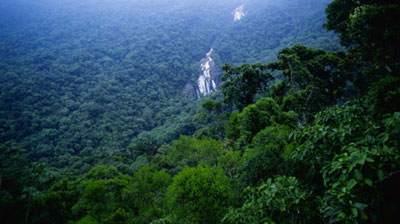 The authors of a new study warn that extreme drought and forest fires will impact Amazonia as temperatures rise, and the over-exploitation of the region’s resources continues to be a major threat to its future. Conservation policy for the Amazon should remain focused on reducing global greenhouse-gas emissions and preventing deforestation, they said.
The authors of a new study warn that extreme drought and forest fires will impact Amazonia as temperatures rise, and the over-exploitation of the region’s resources continues to be a major threat to its future. Conservation policy for the Amazon should remain focused on reducing global greenhouse-gas emissions and preventing deforestation, they said.
The study by University of Michigan evolutionary biologist Christopher Dick and his colleagues demonstrates the surprising age of some Amazonian tree species — more than 8 million years — and thereby shows that they have survived previous periods as warm as many of the global warming scenarios forecast for the year 2100.
The paper is scheduled for online publication Dec. 13 in the journal Ecology and Evolution. The new study is at odds with earlier papers, based on ecological niche-modeling scenarios, which predicted tree species extinctions in response to relatively small increases in global average air temperatures.
“Our paper provides evidence that common Amazon tree species endured climates warmer than the present, implying that — in the absence of other major environmental changes — they could tolerate near-term future warming under climate change,” said Dick, an associate professor of ecology and evolutionary biology and acting director of the U-M Herbarium.
But study co-author Simon Lewis of University College London and the University of Leeds cautioned that “the past cannot be compared directly with the future.”
“While tree species seem likely to tolerate higher air temperatures than today, the Amazon forest is being converted for agriculture and mining, and what remains is being degraded by logging and increasingly fragmented by fields and roads,” Lewis said. “Species will not move as freely in today’s Amazon as they did in previous warm periods, when there was no human influence. Similarly, today’s climate change is extremely fast, making comparisons with the past difficult.
“With a clearer understanding of the relative risks to the Amazon forest, we conclude that direct human impacts, such as forest clearance for agriculture or mining, should remain a focus of conservation policy,” Lewis said. “We also need more aggressive action to reduce greenhouse gas emissions in order to minimize the risk of drought and fire impacts to secure the future of most Amazon tree species.”
Dick and his colleagues used a molecular clock approach to determine the ages of 12 widespread Amazon tree species, including the kapok and the balsa. Then they looked at climatic events that have occurred since those tree species emerged. In general, they inferred that the older the age of the tree species, the warmer the climate it has previously survived.
The researchers determined that nine of the tree species have been around for at least 2.6 million years, seven have been present for at least 5.6 million years, and three have existed in the Amazon for more than 8 million years.
“These are surprisingly old ages,” Dick said. “Previous studies have suggested that a majority of Amazon tree species may have originated during the Quaternary Period, from 2.6 million years ago to the present.”
The 12 tree species used in the study are broadly representative of the Amazon tree flora. Primary forest collection sites were in central Panama, western Ecuador and Amazonian Ecuador. Additional collections were made in Brazil, Peru, French Guiana and Bolivia. Other plant samples were obtained from herbarium specimens.
Science Daily
M.W

